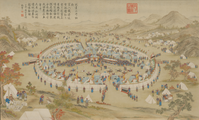| Jean-Damascène Sallusti | |
|---|---|
| Died | 1781 |
| Nationality | Italian |
| Other names | An Deyi |
| Occupation(s) | Bishop of Beijing, Missionary to China, court painter under the Qianlong Emperor |
| Works | "Battle Copper Prints", commemorating the I-li campaign |
Jean-Damascène Sallusti, also Giovanni Damasceno (simplified Chinese: 安德义; traditional Chinese: 安德義; pinyin: Ān Déyì; d. 1781) was an Italian missionary to China, as well as a court painter under the Qianlong Emperor of the Qing dynasty.
A member of the Augustinian order, and later a Jesuit, Sallusti was (somewhat controversially) appointed Bishop of Beijing in 1778, a position he held until his death in 1781. As a painter, he was a contemporary of Giuseppe Castiglione and Ignatius Sichelbart, and with them was responsible for the creation of the Emperor's "Battle Copper Prints", commemorating the I-li campaign. Work by Sallusti is held in the collection of the Cleveland Museum of Art.
-
 Battle of Kurungui
Battle of Kurungui
-
 Battle of Yesil-kol-nor
Battle of Yesil-kol-nor
-
 The Chief of Us-Turfan Surrendering his City
The Chief of Us-Turfan Surrendering his City
-
 The Emperor Greeting The Triumphant Troops Outside of the Capital
The Emperor Greeting The Triumphant Troops Outside of the Capital
-
 The Great Victory at Qurman
The Great Victory at Qurman
-
 The Surrender of the Khan of Badakhsan
The Surrender of the Khan of Badakhsan
References
- Arnold Horrex Rowbotham (January 1966). Missionary and mandarin: the Jesuits at the court of China. Russell & Russell. p. 190. Retrieved 28 May 2013.
- Michael Sullivan (1989). The meeting of Eastern and Western art. University of California Press. pp. 74. ISBN 978-0-520-05902-3. Retrieved 28 May 2013.
- L. Swerts; Mon Van Genechten; K. De Ridder (1 January 2002). Mon Van Genechten (1903-1974): Flemish Missionary and Chinese Painter : Inculturation of Chinese Christian Art. Leuven University Press. p. 18. ISBN 978-90-5867-222-3. Retrieved 28 May 2013.
- Hong Kong Museum of Art (1997). 從北京到凡爾賽: 中法美術交流. 香港市政局. p. 233. ISBN 978-962-215-151-2. Retrieved 28 May 2013.
- Kember, Pamela (18 April 2013). "An Tai". An Tai or An Deyi, An T'ai, Ngan T'ai, An Ruowang, Ngan Jouo-Wang; real name: Giovanni Damasceno Sallust; other names: Salusti or Salutti, Giovanni Damasceno; Jean, Damascène. Oxford University Press. ISBN 978-0-19-992301-4. Retrieved 28 May 2013.
{{cite book}}:|work=ignored (help) - Le Bas, Jacques-Philippe (1770). "A Victory Banquet Given by the Emperor for the Distinguished Officers and Soldiers". World Digital Library (in French). Xinjiang, China. Retrieved 28 May 2013.
- Jacques Gernet (31 May 1996). A History of Chinese Civilization. Cambridge University Press. pp. 522. ISBN 978-0-521-49781-7. Retrieved 28 May 2013.
- "Battle at yixi'er ku'ernao'er/ from battle scenes of the quelling of rebellions in the western regions, with imperial poems". Collection. Cleveland Museum of Art. Archived from the original on 4 March 2016. Retrieved 1 June 2013.
External links
This article about an Italian painter is a stub. You can help Misplaced Pages by expanding it. |
This article about a Catholic bishop or archbishop from China is a stub. You can help Misplaced Pages by expanding it. |
- Jesuit missionaries in China
- Jesuit bishops
- Qing dynasty painters
- 1781 deaths
- 18th-century Italian painters
- Italian male painters
- 18th-century Italian Jesuits
- Italian Roman Catholic missionaries
- Italian emigrants to China
- Italian painter stubs
- Asian Roman Catholic bishop stubs
- Chinese religious biography stubs